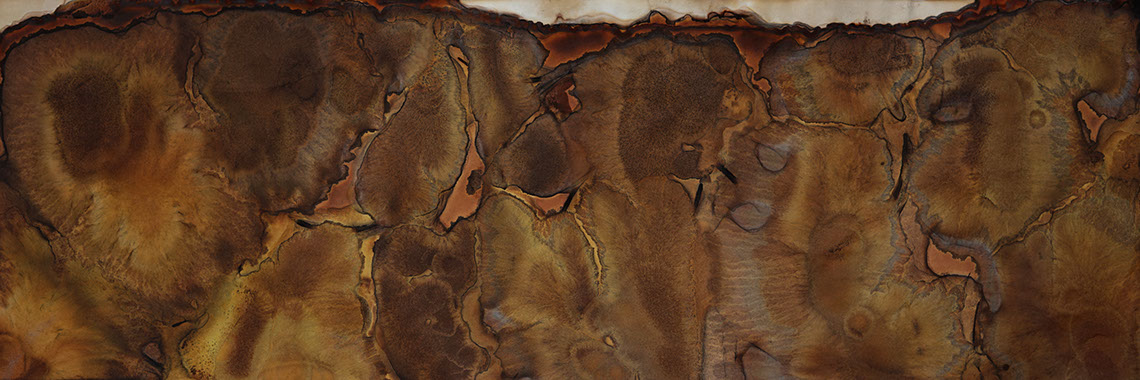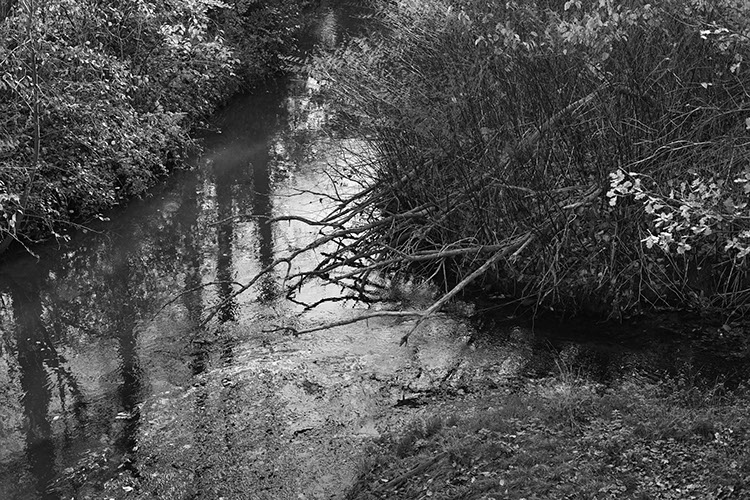

Mapping VI,
Collaborative Chromatography
The river Dommel is a natural fluvial system extending for the length of 146km, originating in Peer, Belgium and joining the river Meuse in the Netherlands. Following my initial curiosity at the sight of the scraped down river banks of the Dommel, I began noticing multiple anthropogenic interventions in the river along
its course; these were consequential measures in response to the high levels of cadmium and zinc contamination in the soil of the river bed. The pollutants were emitted by the nearby zinc-ore smelters in the Flemish Neerpelt, right across the Dutch border, which have been active in producing zinc blocks and sheets for over 125 years. The process of zinc extraction and fusion from metal ores was particularly polluting in the past due to the release of toxic gasses and contaminated water with dissolved zinc and cadmium particles. These industrial waste waters have been dumped for over a century into a ditch, the Eindergatloop, which runs along the border of the terrain, where the water stream carried the pollution further along to merge into the river Dommel. In the 1980s, after 85 years of uncontrolled industrial discharge, it became evident that the river bed of the
Dommel had particularly high levels of zinc and cadmium, both heavy metals which settle and attach to the sediment once the water stream slows down. Soil decontamination projects Dommel, the Netherlands the river have been carried out by the organization Waterschap de Dommel, by scraping the river bottom and banks, and displacing the contaminated ground elsewhere. Despite the reduction of direct pollution from the smelters, the concentration of zinc and cadmium in the river sediment is still dangerously high for both aquatic and terrestrial creatures. These metals have permeated through bodies, from the river into the aquatic flora, and from the displaced earth into the nearby vegetation. Cadmium has also permeated into the bodies of macro invertebrates such as earthworms, and microalgae such as diatoms. These biotas serve scientists as river pollution indicators, and in this story, cadmium and zinc will act as tracers as they continue their permeating journey, leaving behind a trail which reveals how entangled, contaminated and polluted our beyond-human encounters really are. The leitmotif of this story is the ability of zinc and cadmium to permeate through time and environments, and as we will discover, it also has left a thread to follow to its geological origins in Queensland, Australia.
Emu Foot Province.
Queensland, Australia
The zinc industry in Neerpelt operated under various company names, over time fusing with other corporations such as Umicore, the Australian Zinifex and nowadays, Nyrstar. In 2000, Zinifex began importing raw material from the Australian Century Mine, also owned by the then Zinifex corporation.
Between 1999 and 2016, Century Mine was one of the world’s largest open pit zinc mines. Located in North Queensland, an Australian region known for its vast mineral deposits of zinc, copper and silver, the mine sits 250 km north-west of the city of Mount Isa. The surrounding territories to Mount Isa have been the land of the Kalkadoon people for over 60000 years, an indigenous tribe that resided in the Emu Foot Province. Their land was dispossessed in 1884, after the Kalkadoons’ final battle against colonization by white settlers. This war is remembered today as ‘Battle Mountain’, during which 150 Kalkadoon natives were massacred for resisting settlers. Over the course of the following 6 years, between 1878 and 1884, it is estimated that up to 900 Kalkadoon people lost their lives while defending their people and land from incursions. 255 years prior, in 1606, Dutch colonial navigator Willem Jansz had arrived as the first European in Australia by approaching the shores of northern Queensland. His explorations and first European mappings of the continent opened the doors for Australia’s European colonization and exploitation.
Through the lens of permeability, the chain of events uncovered by soil contaminations and abnormal biota indexes have led upstream to Australian colonial history, and as a result, the story of the Kalkadoon people has become linked to the pollution of the river Dommel.

to permeate,
permeability,
permeance,
permeation,
permeating:
the action to diffuse through or penetrate something
[1] Harawaw, D.J. (2016). Staying with the Trouble. Making Kin in the Chthulucene. London, England: Duke University Press
[2] Tsing, A. (2015). The Mushroom at the End of the World, On the Possibility of Life in Capitalist Ruins. Princeton, USA: Princeton University Press
[3] Tsing, A., Swanson, H., Gan, E., & Bubandt, N. (2017). Arts of living on a damaged planet. Minnesota, USA: University of Minnesota Press
Contaminating [short fiction]
My history lies among the geologic layers of my forefathers and mothers. For millennia I have rested in peace, left untouched, my land respected and cared for. Strangers saw value in me, they cut into the Earth, left an open sore where I used to lay. They wanted me, extracted what they were looking for, ripped me open, melted away my body, washed away what they feared, discarded me as waste.
I entered the river, my body rested heavily on its bed. This became my new home. Parts of me were restless, I looked for other places to lay. I entered the body of earthworms. I searched among diatoms, but most of them died. I approached the water plants, then the plants on the river side. I lingered there for a while, then grazers came along and I lay in their bodies, I rested in their livers.
And now that you have come to break my peace, I realize that my journey to my resting place continues.
I enter through the skin of your fingertips.
I am cadmium.